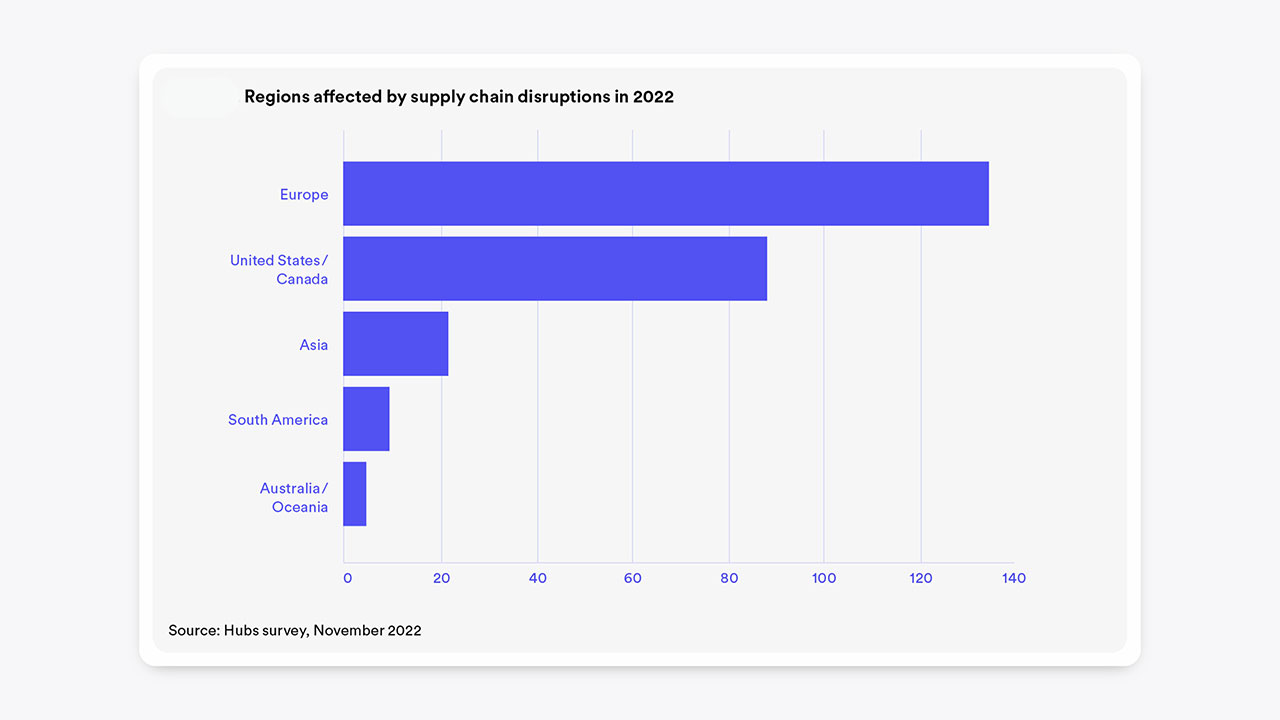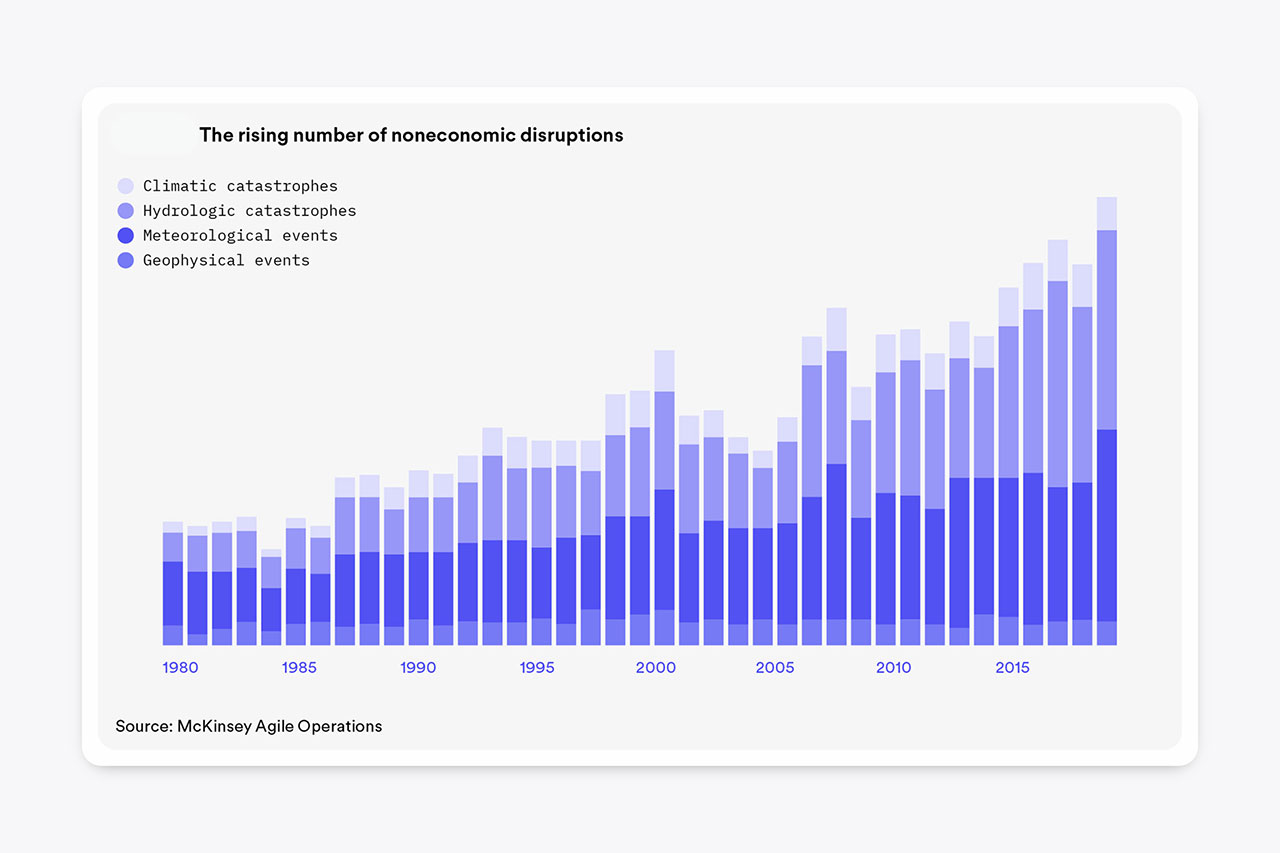If you had issues with supply chain disruptions or faced material shortages recently, you’re not alone. A survey conducted by our digital network team at Hubs in November 2022 found that more than three-quarters of companies experienced some form of external supply chain disruption during the past year. This represents a significant increase compared to the results of the surveys we conducted in 2020 and 2021. In the 2022 survey, material shortages were the top challenge, affecting 60.9% of participants. Likewise, roughly half of all respondents reported facing material shortages more often in 2022 compared to 2021.
COVID-19 was the second biggest cause of disruptions, affecting 57% of companies in 2022. China's strict lockdowns, driven by its zero COVID policy, have severely affected the manufacturing output in the world's manufacturing powerhouse. For example, the output of Apple iPhones is likely to drop by 30% due to COVID-related curbs at Foxconn's factory in Zhengzhou, leading to a shift of some iPhone production to India. Other significant concerns among survey respondents included rising energy costs, logistics issues, container shortages, port congestion, natural disasters, and trade wars.
With a military conflict at its door, businesses in Europe experienced widespread supply chain disruptions. In contrast, Asia, home to manufacturing hubs such as China and India, fared better.
The automation/robotics industry was the most affected by supply chain disruptions, followed by the electronics and medical corporations.
Key Differences Between 2021 and 2022 Survey Findings
- The latest survey shows that 70% of participants have implemented measures to improve their supply chain resilience, compared to 63% in 2021. This indicates that companies are increasingly recognizing the importance of preparing for supply chain disruptions.
- In the 2021 survey, 26.8% of respondents considered the pandemic to be a major supply chain concern. This number has increased significantly in the 2022 survey, with 57% of respondents citing it as the second biggest concern.
- 4% of respondents reported experiencing more raw material shortages in 2022 compared to 2021.
According to our survey, there were six primary supply chain disruptors in 2022:
- Russia-Ukraine war
- U.S.-China trade war
- Worker strikes
- Rising shipping costs
- Natural disasters
- Cybersecurity
Russia-Ukraine War
In addition to the tragic loss of lives, the ongoing Russia-Ukraine war has significantly affected global supply chains. The conflict has disrupted essential air freight and shipping routes, leading to disruptions in the supply of raw materials and finished goods. Unsurprisingly, almost half of the 2022 survey respondents reported that the war affected their company.
The war has far-reaching consequences. In 2020, Russia accounted for approximately 29% of crude oil and 43% of natural gas imports into the EU. The fresh round of sanctions against Russia has led to a significant increase in energy costs across Europe. As a result, many metal and chemical factories in Europe went dark in 2022. This aligns with the findings of our survey, where 55% of respondents expressed concern about the effect of rising energy costs on their businesses, and 55.6% of participants were worried about the impact of these costs on Europe's manufacturing capabilities. Energy costs in the United States also rose significantly in response to reduced oil supplies in the world market.
The U.S.-China Trade War Continues
The increased tariffs and trade barriers between the U.S. and China have disrupted the flow of goods and materials between the two countries. This has made it more expensive and difficult for businesses to import and export goods. As a result, many businesses have had to find alternative suppliers or production locations, disrupting their supply chains and increasing their costs. The uncertainty and instability caused by the trade war have also made it harder for businesses to effectively plan and manage their supply chains.
In what's now considered a new cold war, the U.S. recently doubled down on its efforts to deprive China of semiconductor technology. In addition to the organizations, the U.S. government now bars its citizens from supporting the development or production of advanced chips at Chinese facilities.
Worker Strikes Across the Globe
The U.S. saw more worker strikes in the first half of 2022 than in all of 2021. North of the border, Canada was hit by the truckers' protest that impaired that country’s supply chains. Across the pond, U.K. port worker strikes strained supply chains. Spain also faced supply chain issues driven by truck drivers' strikes. Meanwhile in South Korea, the truckers' protests disrupted production as well as the supply chain.
Rising Shipping Costs Hurt Bottom Lines
The steep rise in shipping costs significantly affected businesses across the globe. In March 2022, it cost an average of nearly $10,000 to ship a 40ft. freight container, almost seven times more than in March 2020.
The higher freight costs contribute to the overall cost of goods and materials, making it more difficult for businesses to compete in the global marketplace. The increased shipping costs are an obstacle for businesses looking to access new markets and ultimately eat into profits for established businesses, making supply chain management more challenging.
Natural Disasters
In recent decades, the world has faced more frequent and increasingly severe natural disasters. Hurricanes, floods, fires, and droughts have devastated communities and entire ecosystems. They have a major impact on supply chains, too. They can halt or slow production, reroute resources, damage vital infrastructure, and more. Natural disasters cannot themselves be prevented, but their impacts can be mitigated through strategic investments and reinforcing supply chains.
In the year 2021 alone, 401 natural disasters were recorded globally. In the U.S., natural disasters cost the economy roughly $145 billion in 2021, making it the third costliest year after 2017 and 2005.
In summer 2022, a record-breaking heat wave and drought in China caused disruptions and even closures of shipping routes, including the vital Yangtze River. As a consequence, China experienced an energy crisis. Automakers with facilities in Sichuan—both Toyota and Tesla have operations there—were forced to halt production due to power cuts, causing adverse effects for the Chinese economy and global automotive supply chains.
Cargo shipments along the Rhine, one of Europe's key trade routes, were also slowed due to a summer drought. Delays caused by the drought were expected to slow Germany's economic growth in 2022 by as much as half a percentage point.
In the U.S., Hurricane Ian caused more than $60 billion in damage and cut Florida's economic growth in Q3 by 2% in both Florida and South Carolina. Flooding in Southeast Australia in October 2022 is expected to cost the country $5 billion in lost economic activity and drive inflation up by 0.1 percentage points.
Cybersecurity
As companies become increasingly reliant on digital solutions to accelerate and streamline operations, it becomes more important to invest in robust cybersecurity measures and technologies. Today, cybersecurity threats, such as data breaches and ransomware, pose a real danger to intellectual property (IP) and supply chains. Weak security systems, software vulnerabilities, supplier fraud, and third-party integrations can lead to financial losses and operational disruptions.
In Japan, manufacturers have been the biggest targets for cyberattacks, with data and entire digital systems held for ransom. Toyota was forced to shut down domestic production in Japan after a cyberattack at a major supplier in Q1 2022. The event illustrated how a single supplier undergoing a cyberattack can bring an entire production chain to a standstill.
In 2021, IT solutions company Kesaya was the victim of a supply chain ransomware attack, which in turn compromised as many as 1,500 businesses around the globe. In Sweden, 800 Coop grocery stores were forced to close because the attack had shut down their cash register operating systems.
Cybercrime reportedly cost U.S. businesses more than $6.9 billion in 2021—an increase of $2.7 billion from 2020. The same year, 62% of large enterprises in IT, security, development, and DevOps, reported experiencing a software supply chain cyberattack—and 31% reported it having a significant or moderate impact.

If you have any issues getting your guide, click here to download.












